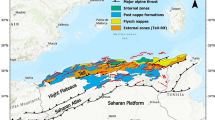Abstract
By linear regression and orthogonal regression methods, comparisons are made between different magnitudes (local magnitude M L, surface wave magnitudes M S and M S7, long-period body wave magnitude m B and short-period body wave magnitude m b) determined by Institute of Geophysics, China Earthquake Administration, on the basis of observation data collected by China Seismograph Network between 1983 and 2004. Empirical relations between different magnitudes have been obtained. The result shows that: ① As different magnitude scales reflect radiated energy by seismic waves within different periods, earthquake magnitudes can be described more objectively by using different scales for earthquakes of different magnitudes. When the epicentral distance is less than 1 000 km, local magnitude M L can be a preferable scale; In case M<4.5, there is little difference between the magnitude scales; In case 4.5<M<6.0, m B> M S, i.e., M S underestimates magnitudes of such events, therefore, m B can be a better choice; In case M>6.0, M S>m B>m b, both m B and m b underestimate the magnitudes, so M S is a preferable scale for determining magnitudes of such events (6.0<M<8.5); In case M>8.5, a saturation phenomenon appears in M S, which cannot give an accurate reflection of the magnitudes of such large events; ② In China, when the epicentral distance is less than 1 000 km, there is almost no difference between M L and M S, and thus there is no need to convert between the two magnitudes in practice; ③ Although M S and M S7 are both surface wave magnitudes, M S is in general greater than M S7 by 0.2∼0.3 magnitude, because different instruments and calculation formulae are used; ④ m B is almost equal to m b for earthquakes around m B4.0, but m B is larger than m b for those of m B≥4.5, because the periods of seismic waves used for measuring m B and m b are different though the calculation formulae are the same.
Similar content being viewed by others
References
Ambrasseys N N. 1990. Uniform magnitude re-evaluation of European earthquakes associated with strong-motion records [J]. Earthquake Engineering & Structural Dynamics, 19: 1–20.
Carroll R I and Ruppert D. 1996. The use and misuse of orthogonal regression in linear errors-in-variables models [J]. The American Statistician, 50(1): 1–6.
CHEN Pei-shan, ZUO Zhao-rong and XIAO Hong-cai. 1988. Determination of surface wave magnitudes by 763 long-period seismograph network [J]. Acta Seismologica Sinica, 10(1): 11–24 (in Chinese).
CHEN Pei-shan. 1989. An overview of the development of surface wave magnitude determination [J]. Seismological and Geomagnetic Observation and Research, 10(6): 1–9 (in Chinese).
CHEN Yun-tai and LIU Rui-feng. 2004. Earthquake magnitude [J]. Seismological and Geomagnetic Observation and Research, 25(6):1–12 (in Chinese).
CHEN Yun-tai, WU Zhong-liang, WANG Pei-de, et al. 2000. Digital Seismology [M]. Beijing: Seismological Press: 1–30 (in Chinese).
Draper N R and Smith H. 1998. Applied Regression Analysis: Third Edition [M]. New York: John Wiley & Sons: 100–125.
Fuller W A. 1987. Measurement Error Models [M]. New York: John Wiley & Sons: 20–30.
GUO Lü-can, and PANG Ming-hu. 1981. Surface wave magnitude of earthquakes and its station correction [J]. Acta Seismologica Sinica, 3(3): 312–320 (in Chinese).
Gutenberg B and Richter C F. 1942. Earthquake magnitude, intensity, energy and acceleration [J]. Bull Seism Soc Amer, 32: 163–191.
Gutenberg B and Richter C F. 1944. Frequency of earthquakes in California [J]. Bull Seism Soc Amer, 34: 185–188.
Gutenberg B and Richter C F. 1956a. Earthquake magnitude, intensity, energy and acceleration [J]. Bull Seism Soc Amer, 46: 105–145.
Gutenberg B and Richter C F. 1956b. Magnitude and energy of earthquakes [J]. Annali di Geofisica, 91: 1–15.
Gutenberg B. 1945a. Amplitude of surface waves and magnitude of shallow earthquakes [J]. Bull Seism Soc Amer, 35: 3–12.
Gutenberg B. 1945b. Amplitudes of P, PP and S and magnitude of shallow earthquakes [J]. Bull Seism Soc Amer, 35: 57–69.
Gutenberg B. 1945c. Magnitude determination for deep-focus earthquakes [J]. Bull Seism Soc Amer, 35: 117–130.
Kanamori H. 1983. Magnitude scale and quantification of earthquakes [J]. Tectonophysics, 93: 185–200.
Kárnĭk V, Kondorskaya N V, Riznichenko Y V, et al. 1962. Standardization of the earthquake magnitude scale [J]. Studia Geophysica et Geodaetica, 6(1): 41–48.
LI Shan-bang. 1981. Earthquakes in China [M]. Beijing: Seismological Press: 1–30 (in Chinese).
LIU Rui-feng, CHEN Yun-tai, Peter Bormann, et al. 2006. Comparison between earthquake magnitudes determined by China seismograph network and US seismograph network (II): Surface wave magnitude [J]. Acta Seismologica Sinica, 19(1): 1–7.
Madansky A. 1959. The fitting of straight lines when both variables are subject to error [J]. J Amer Statist Assoc, 54: 173–205.
Richter C F. 1935. An instrumental earthquake magnitude scale [J]. Bull Seism Soc Amer, 25: 1–32.
SHI Zhen-liang, ZHANG Shao-quan, ZHAO Rong-guo, et al. 1990. Handbook for Seismology Work [M]. Beijing: Seismological Press: 123–132 (in Chinese).
State Seismological Bureau. 1978. Technical Specification for Seismic Station Observation [M]. Beijing: Seismological Press: 1–12 (in Chinese).
Utsu T. 1982. Relationships between magnitude scales [J]. Bull Earthq Res Inst, Univ of Tokyo, 57: 465–497.
Utsu T. 2002. Relationships between magnitude scales [M]//Lee W H K, Kanamori H, Jennings P C, et al. International Handbook of Earthquake and Engineering Seismology: Part A. San Diego: Academic Press: 733–746.
XU Shao-xie, LU Yuan-zhong, GUO Lü-can, et al. 1994. General Ruler for Earthquake Magnitude (GB17740-1999) [S]. Beijing: China Standard Press: 1–7 (in Chinese).
Author information
Authors and Affiliations
Corresponding author
Additional information
Foundation item: Special Project on Earthquake from Ministry of Science and Technology of China.
About this article
Cite this article
Liu, Rf., Chen, Yt., Ren, X. et al. Comparison between different earthquake magnitudes determined by China Seismograph Network. Acta Seimol. Sin. 20, 497–506 (2007). https://doi.org/10.1007/s11589-007-0497-x
Received:
Accepted:
Issue Date:
DOI: https://doi.org/10.1007/s11589-007-0497-x




